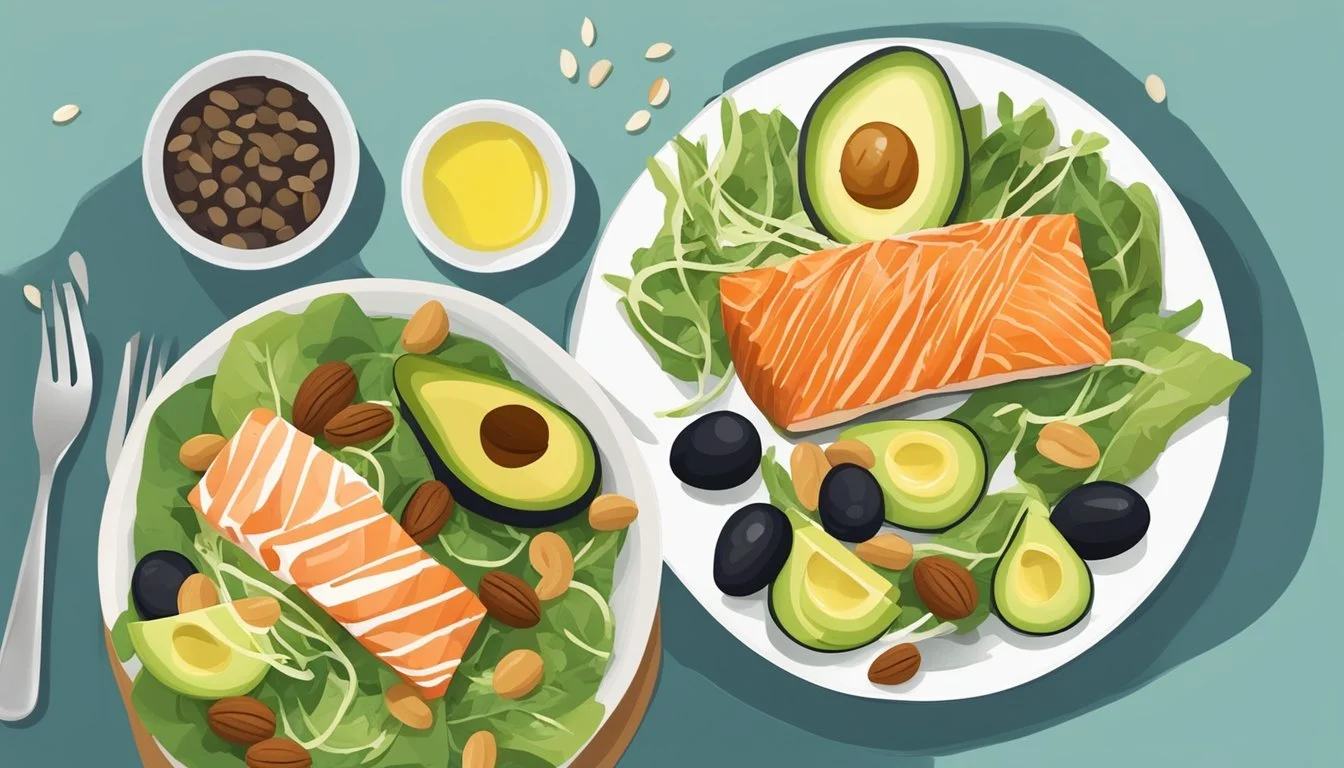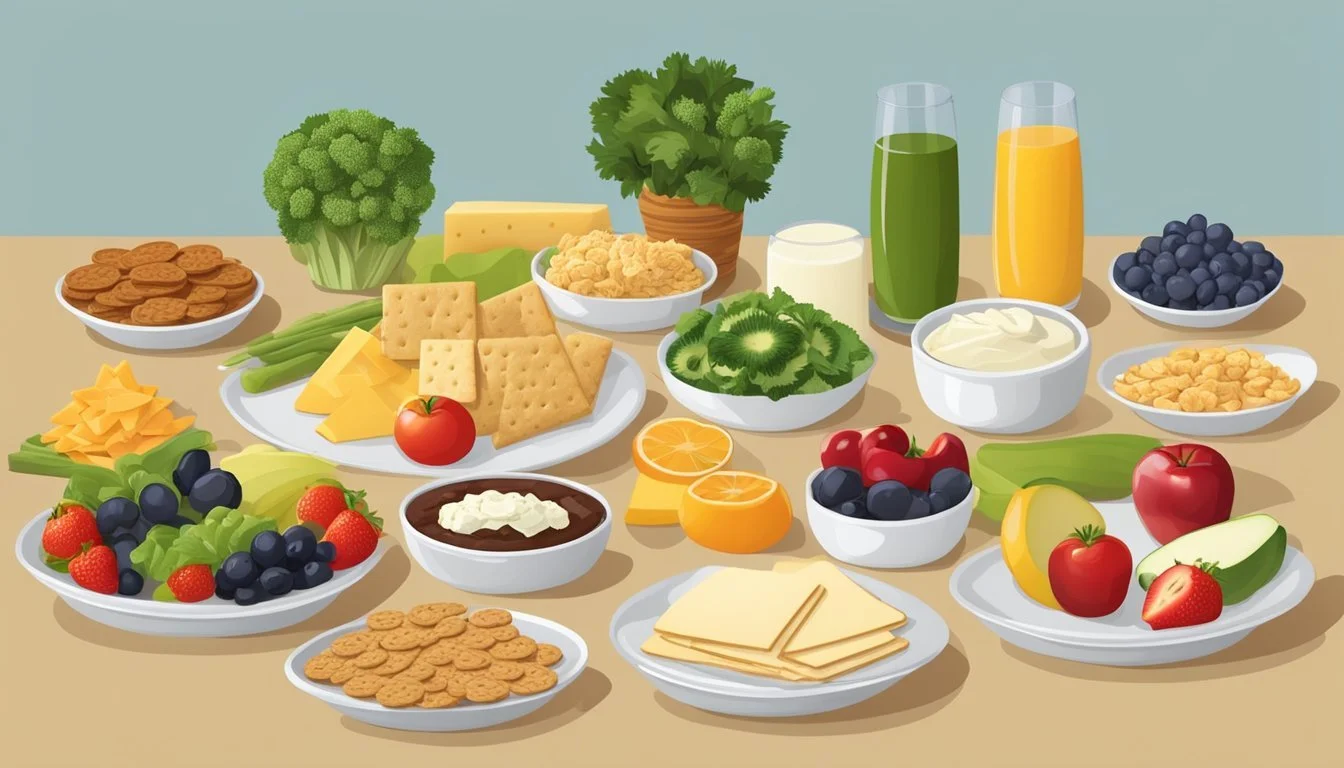Delicious and Diabetes-Friendly Light Lunch Ideas for Better Blood Sugar Control
Managing diabetes involves careful consideration of food choices, especially when it comes to lunch. A well-planned midday meal can help stabilize blood sugar levels and provide essential nutrients. Diabetes-friendly lunch ideas focus on incorporating complex carbohydrates, lean proteins, and fiber-rich vegetables while limiting saturated fats and added sugars.
Healthy lunch options for people with diabetes don't have to be complicated or time-consuming. Quick and easy meals can be both nutritious and satisfying. From salads and sandwiches to soups and wraps, there are numerous possibilities that cater to various tastes and dietary preferences.
By making smart lunch choices, individuals with diabetes can maintain energy levels throughout the day and support their overall health goals. Planning ahead and having a repertoire of go-to recipes can make it easier to stick to a diabetes-friendly eating plan, even on busy days.
Understanding Diabetes and Nutrition
Nutrition plays a crucial role in managing diabetes effectively. Proper food choices help regulate blood sugar levels and support overall health. Balancing carbohydrates, fiber, and fats is key to creating diabetes-friendly meals.
The Role of Carbohydrates in Blood Sugar Control
Carbohydrates have the most significant impact on blood sugar levels. They break down into glucose during digestion, causing blood sugar to rise. People with diabetes need to monitor their carbohydrate intake carefully.
The glycemic index (GI) measures how quickly carbs raise blood sugar. Low-GI foods are preferable for diabetes management. These include:
Legumes
Non-starchy vegetables
Some fruits
Portion control is essential. Spreading carbohydrates evenly throughout the day helps maintain stable blood sugar levels.
Importance of Fiber for Digestive Health
Fiber is a type of carbohydrate that doesn't raise blood sugar. It offers numerous benefits for people with diabetes:
Slows digestion, reducing blood sugar spikes
Promotes feelings of fullness, aiding weight management
Supports digestive health and regular bowel movements
May help lower cholesterol levels
Good fiber sources include:
Vegetables
Fruits
Whole grains
Aim for 25-30 grams of fiber daily. Increase intake gradually to avoid digestive discomfort.
Fat Considerations for a Diabetes-Friendly Diet
Not all fats are created equal. Choosing the right types of fat is important for diabetes management and heart health.
Healthy fats to include:
Monounsaturated fats: avocados, olive oil, nuts
Polyunsaturated fats: fatty fish, flaxseeds, walnuts
Limit saturated fats found in red meat and full-fat dairy products. These can increase cholesterol levels and heart disease risk.
Trans fats should be avoided completely. They're often found in processed foods and can negatively impact heart health.
Incorporating healthy fats in moderation can help improve insulin sensitivity and blood sugar control.
Protein-Rich Foods for Blood Sugar Management
Incorporating protein-rich foods into meals helps stabilize blood sugar levels and promotes satiety. Lean animal proteins and plant-based options provide essential nutrients while supporting diabetes management.
The Benefits of Lean Proteins
Lean proteins are excellent choices for blood sugar control. Chicken breast, turkey, and fish like tuna and salmon are low in saturated fat and high in protein. These foods have minimal impact on blood glucose levels.
Eggs are a versatile protein source packed with nutrients. They can be prepared in various ways for quick, diabetes-friendly meals.
Shrimp is another lean protein option that's low in calories and carbohydrates. It can be easily added to salads or stir-fries for a protein boost.
Plant-Based Proteins and Diabetes
Plant-based proteins offer fiber and nutrients that support blood sugar management. Tofu is a versatile soy product rich in protein and low in carbohydrates.
Legumes like lentils, chickpeas, and black beans provide protein and fiber. These nutrients slow digestion and help prevent blood sugar spikes.
Nuts and seeds are protein-packed snacks that also contain healthy fats. Almonds, walnuts, and chia seeds make great additions to meals or as standalone snacks.
Quinoa is a complete protein source that can replace refined grains in meals. It provides sustained energy without causing rapid blood sugar fluctuations.
Incorporating Healthy Fats into Lunches
Including healthy fats in diabetes-friendly lunches helps regulate blood sugar and provides essential nutrients. These fats play a crucial role in heart health and overall well-being.
Choosing the Right Fats for Heart Health
Monounsaturated and polyunsaturated fats are ideal choices for people with diabetes. These fats can help lower bad cholesterol levels and reduce inflammation in the body.
Nuts and seeds are excellent sources of healthy fats. Almonds, walnuts, chia seeds, and flaxseeds can be easily added to salads or eaten as snacks.
Olive oil is a versatile option for dressings and cooking. It contains antioxidants that protect against cell damage.
Adding a quarter of an avocado to sandwiches or salads boosts healthy fat intake. Avocados are rich in fiber and potassium, supporting digestive and heart health.
The Power of Omega-3s in Avocado and Olive Oil
Omega-3 fatty acids offer significant anti-inflammatory benefits. These essential fats are found in avocados and olive oil, making them valuable additions to diabetes-friendly lunches.
Avocados contain alpha-linolenic acid (ALA), a plant-based omega-3. This nutrient helps reduce the risk of heart disease and supports brain function.
Olive oil is rich in oleic acid, which has similar effects to omega-3s. It can help lower inflammation and improve insulin sensitivity.
Combining these foods in meals, such as an avocado and olive oil dressing on a salad, maximizes their benefits. This pairing provides a potent mix of heart-healthy fats and anti-inflammatory compounds.
Vegetables: A Cornerstone of Diabetes-Friendly Lunches
Vegetables are essential for crafting nutritious and delicious diabetes-friendly lunches. They provide fiber, vitamins, and antioxidants while helping to control blood sugar levels.
Leafy Greens and Non-Starchy Options
Leafy greens like spinach and kale are excellent choices for diabetes management. They're low in carbohydrates and high in nutrients. Spinach offers iron and vitamin K, while kale provides calcium and vitamin C.
Non-starchy vegetables such as broccoli, cauliflower, zucchini, and cucumber are also valuable additions to a diabetes-friendly lunch. These vegetables are rich in fiber, which aids digestion and helps regulate blood sugar.
Tomatoes, though technically a fruit, are often used as a vegetable in meals. They're low in carbohydrates and contain lycopene, an antioxidant that may help reduce the risk of heart disease.
Creating Flavorful Veggie-Centric Dishes
Vegetable-based lunches can be both satisfying and diabetes-friendly. A colorful salad with mixed greens, cucumber, and tomatoes provides a nutrient-rich base. Adding grilled zucchini or roasted cauliflower can increase the meal's satiety factor.
Veggie wraps using large lettuce leaves instead of tortillas offer a low-carb alternative. Fill them with a mixture of chopped vegetables and lean protein for a balanced meal.
Vegetable soups, especially those made with non-starchy options, can be an excellent choice for a light yet filling lunch. A broccoli or cauliflower soup, for instance, offers warmth and nutrition without excessive carbohydrates.
Low-Carb and Whole Grain Options
Balancing carbohydrates is crucial for managing diabetes. Incorporating low-carb options and nutrient-dense whole grains can help stabilize blood sugar levels while providing essential nutrients.
Benefits of Whole Grains Over Refined Carbohydrates
Whole grains offer numerous advantages for people with diabetes. They contain more fiber, vitamins, and minerals than refined carbohydrates. This higher fiber content slows digestion, leading to a more gradual rise in blood sugar.
Whole-grain bread, brown rice, and quinoa are excellent choices. These foods have a lower glycemic index compared to their refined counterparts. Whole grain pasta provides complex carbohydrates that release energy slowly.
Incorporating whole grain tortillas into wraps or sandwiches adds nutritional value to meals. These options help maintain satiety for longer periods, reducing the likelihood of unhealthy snacking between meals.
Low-Carb Alternatives for Traditional Lunch Choices
For those seeking to reduce carbohydrate intake, several alternatives can replace traditional high-carb lunch items. Lettuce wraps serve as a crisp, low-carb substitute for bread or tortillas.
Cauliflower rice offers a versatile low-carb base for bowls or stir-fries. It can be seasoned to mimic the flavor of traditional rice dishes. Zucchini noodles, or "zoodles," make an excellent pasta replacement in cold or hot dishes.
Portobello mushroom caps can be used as burger buns or pizza bases. Cloud bread, made primarily from eggs and cream cheese, serves as a bread alternative for sandwiches or toast.
These low-carb options allow for creative and satisfying lunches while helping to manage blood sugar levels effectively.
Easy Diabetes-Friendly Lunch Recipes
Preparing nutritious and satisfying lunches is crucial for managing diabetes. These recipes focus on balanced ingredients that help maintain stable blood sugar levels while providing essential nutrients.
Salads Packed with Protein and Fiber
Tuna salad offers a protein-rich base for a filling lunch. Mix canned tuna with Greek yogurt instead of mayonnaise for a lighter option. Add chopped celery, red onion, and a squeeze of lemon juice for extra flavor and crunch.
Quinoa salad combines protein and fiber in one dish. Cook quinoa and let it cool. Toss with diced cucumber, cherry tomatoes, and feta cheese. Drizzle with olive oil and lemon juice for a refreshing dressing.
A chopped salad provides a variety of textures and nutrients. Combine mixed greens, diced chicken breast, hard-boiled eggs, and a variety of colorful vegetables. Top with a light vinaigrette dressing.
Hearty Bowls: Balancing Grains and Greens
Burrito bowls offer a customizable lunch option. Start with a base of brown rice or cauliflower rice. Add black beans, grilled chicken or tofu, and plenty of non-starchy vegetables like bell peppers and onions.
Lentil bowls provide plant-based protein and fiber. Cook lentils and mix with roasted vegetables such as sweet potatoes and broccoli. Drizzle with a tahini dressing for added flavor.
Create a Greek-inspired bowl with quinoa, cucumber, tomatoes, olives, and a small amount of feta cheese. Add grilled chicken or chickpeas for extra protein.
Creative Sandwiches with Low-Glycemic Impact
Hummus sandwiches offer a plant-based option. Spread whole-grain bread with hummus and layer with cucumber slices, tomatoes, and lettuce. Add sprouts or microgreens for extra nutrients.
Egg salad can be made diabetes-friendly by using Greek yogurt instead of mayonnaise. Mix mashed hard-boiled eggs with Greek yogurt, diced celery, and a touch of mustard. Serve on whole-grain bread or lettuce wraps.
Try an open-faced sandwich using a single slice of whole-grain bread. Top with mashed avocado, sliced turkey breast, and tomato slices. This reduces the carbohydrate content while still providing a satisfying meal.
Snack Pairings and Sides
Complementing diabetes-friendly lunches with nutritious snacks and sides enhances meal satisfaction and helps maintain stable blood sugar levels. Vegetables, fruits, and protein-rich options provide essential nutrients and fiber.
Vegetable Sides and Their Benefits
Mixed greens offer a low-calorie, nutrient-dense side option. They contain vitamins A, C, and K, as well as folate and fiber. Sprouts add a crunchy texture and are rich in antioxidants. Cucumbers provide hydration and are low in carbohydrates, making them an excellent choice for diabetes management.
Olives, while higher in fat, contain heart-healthy monounsaturated fats. They can be enjoyed in moderation as part of a balanced meal. A small serving of olives pairs well with mixed greens or as a standalone snack.
For a quick and easy vegetable side, try a simple salad of mixed greens, sprouts, and sliced cucumbers. Drizzle with a light vinaigrette for added flavor without excess calories.
Fruit and Yogurt for Balanced Snacking
Sliced apples make an excellent snack or side for diabetes-friendly lunches. They are high in fiber and contain natural sugars that, when paired with protein, help maintain steady blood glucose levels. Apples can be enjoyed with a tablespoon of nut butter for added protein and healthy fats.
Greek yogurt is a protein-rich option that complements fruit well. It contains probiotics that support gut health and can help improve insulin sensitivity. Choose plain, unsweetened Greek yogurt to avoid added sugars.
Try pairing sliced apples with Greek yogurt for a balanced snack. Add a sprinkle of cinnamon for flavor and potential blood sugar management benefits. This combination provides protein, fiber, and nutrients to support overall health and diabetes management.
Tips for Eating Out with Diabetes
Dining out with diabetes requires careful planning and mindful choices. By selecting nutrient-dense options and being aware of portion sizes, individuals can enjoy restaurant meals while managing their blood sugar levels effectively.
Making Smart Menu Choices
Choose restaurants that offer detailed nutritional information. Request grilled, baked, or steamed dishes instead of fried options. Opt for lean meats like chicken, fish, or turkey. Include plenty of non-starchy vegetables in your meal.
Ask for sauces and dressings on the side to control portions. Choose whole grain options when available. Consider splitting a large entrée with a dining companion to manage portion sizes.
Limit high-carb sides like fries or mashed potatoes. Instead, request extra vegetables or a side salad. For dessert, fresh fruit or a small portion of a sugar-free option can satisfy cravings without spiking blood sugar.
Navigating Fast Food for Diabetes
Fast food can be challenging for those with diabetes, but it's not impossible to make healthier choices. Look for menu items with lower carb counts. Many chains now offer salads with grilled chicken or fish.
Choose water, unsweetened tea, or diet beverages instead of sugary drinks. Opt for smaller portion sizes or kid's meals to control calorie and carb intake. Remove buns from burgers and wraps to reduce carbs.
Select grilled options over breaded or fried items. Add extra vegetables to sandwiches or burgers when possible. Be cautious with condiments and dressings, as they can add hidden sugars and calories.
Meal Planning and Prep for Long-Term Success
Effective meal planning is crucial for managing diabetes and maintaining a healthy diet. By dedicating time to plan and prepare meals in advance, individuals can ensure they have nutritious options readily available.
A key strategy is to focus on simple ingredients that are diabetes-friendly. Whole grains, lean proteins, and non-starchy vegetables form the foundation of balanced meals.
Creating a weekly meal schedule helps streamline grocery shopping and reduces the likelihood of impulsive food choices. This approach also allows for better portion control and carbohydrate management.
Batch cooking is an efficient way to prepare multiple meals at once. Roasting a large tray of mixed vegetables can provide the base for various lunches throughout the week.
Veggie bowls are versatile and customizable options for diabetes-friendly lunches. Combining roasted or raw vegetables with a lean protein and a small portion of whole grains creates a satisfying meal.
Meal Prep Ideas:
Chop vegetables for quick salads
Cook and portion lean proteins
Prepare whole grains in batches
Make homemade dressings and sauces
Green goddess salad with chickpeas is an excellent example of a nutritious, diabetes-friendly lunch. It combines fiber-rich legumes with fresh vegetables and a flavorful dressing.
Investing in quality food storage containers helps keep prepped ingredients fresh and makes it easy to assemble meals quickly. This approach supports long-term success in managing diabetes through consistent, healthy eating habits.









